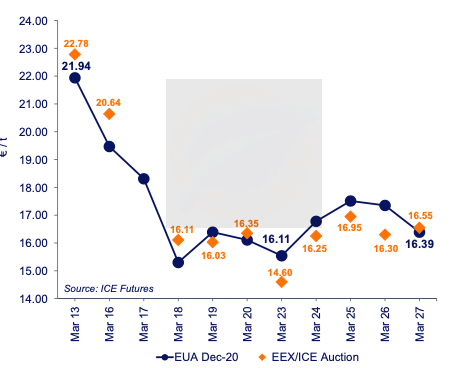The European CO2 Market – 20.10.2020
Get ready for the 2020 EU-ETS Compliance:
Borrowing allowances from Phase 4 not allowed
Phase 4 starts on January 1, 2021. As a compliance entity, are you wondering if you can use the free allocation of allowances that you will receive in Q1 2021 to fulfill the year 2020 compliance?
Read more and find out what you should get prepared for.
What is borrowing in the EU-ETS, and how does it work?
Borrowing in the EU-ETS means using allowances from future periods for compliance today. The allowances allocated in February are often used for surrendering in April that same year by some companies.
This is because the allocation of allowances takes place in February each year, but the surrender of allowances for the previous year takes place after this date, by the end of April. Therefore, EU-ETS compliance entities can use some of their new allocation to count towards the previous year’s compliance obligation.
However, the practice of borrowing is not allowed between 2 trading phases.
Emission allowances allocated in Phase 4 (from 1 January 2021 onwards) will not be accepted for the compliance of phase 3.
What should you expect for the year 2020 Compliance?
Phase 4 starts on January 1, 2021. The first free allocation of phase 4 allowances is scheduled for February 2021. However, it is important to underline that, in April 2021, the emissions of the last year of phase 3 (2013-2020) still have to be compensated. The compensation for 2020 emissions must be achieved by surrendering phase 3 allowances.
The registry will therefore not allow surrendering of phase 4 allowances to compensate for Compliance 2020. Participants of the EU-ETS system (operator and aircraft operators) must therefore ensure to have sufficient Phase 3 allowances for Compliance 2020 in their account(s).
Identify them: Phase 3 and Phase 4 allowances
Phase 4 allowances can be identified by a marking indicating that they are from Phase 4, at least until 1 May 2021.
Please note that all Phase 4 allowances, both the auctioned allowances and the allowances distributed through free allocation in year 2021 will be identified as indicated above. These cannot be used for Compliance of year 2020.
Use of CERs in Phase 4
CERs can no longer be used in phase 4 of the EU ETS. Up to 30 April 2021 at the latest, EU-ETS Compliance Entities can exchange CERs for Phase 3 emission allowances (EUA/EUAA).
From 1 May 2021 onwards, incoming transactions with CERs will no longer be allowed in EU accounts.
So, it is recommended to verify your remaining entitlement to exchange CER/ERU for phase 3 allowances as soon as possible since transactions with CERs/ERUS will not be any more accepted in the phase 4.
The ICE ECX exchange from London opened this morning (20.10.2020) its EUA trade sessions at 24.98 Euro/tCO2, 0.36% more than the previous day.
Source: Aither Group and ICE ECX, London



